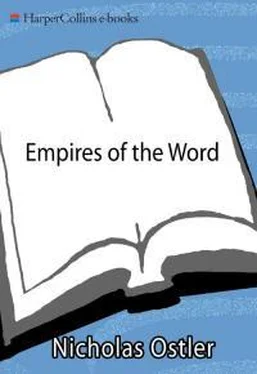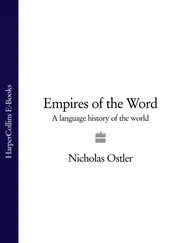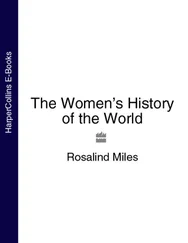Bauer (1996: 33-40).
Anderson (1991: 133-4).
Krauss (2001: 19).
Crystal (2003: 191).
Better known in the corrupted form Montezuma. Phonetically, it was moteukzoma.
In each chapter, a convenient form of romanised spelling has been adopted, to do justice to the pronunciation of fragments of an unfamiliar language, while not diverging too far from non-linguists’ ideas of how the Roman alphabet is pronounced. In general, vowels are to be pronounced pure and simple, as in Spanish, consonants and clusters as in English, and any peculiarities are announced in the first footnote. Here, for Nahuatl, the traditional (Spanish-like) romanisation has not been followed: instead, č represents English ch, and š English sh; h is used for the glottal stop, like the unheard t in the English and Scots pronunciation of Scotland ; z here is closer to English s than z. Long vowels have a macron: ā, ē, … Common words may be simplified: e.g., stricty, it is tlahloāni.
Ka ōyahkeh motēčīuhkāwān, in tlahtohkeh, in Ilzkōwātzin, in wēweh Motēukzoma, in Āšāyaka, in Tizōzik, in Āwltzōtl, in ō kuēl ačīk mitzommotlaplyalīlikoh, in ōkipačōkoh in ātl in tepetl in Mešihko, in īnkuitlapan, īntepotzko in ōwalyetiyā in momāzēwaltzin.
Kuix ok wāllamatih in īmonihka, in intepotzko? Mā zēmeh yehwāntin kitztiyānih, kimāwizzōtiānih in nehwātl in āxkān nopan ōmočīuh, in ye nikitta, in zā īmonihka īntepotzko totēukyōwān. Kamo zan nitēmiki, ahmō zan nikočitlēwa, ahmō zan nikkočitta, ahmō zan niklēmiki, ka yē ōnimitznottili, mīštzinko ōnitlačiš.
Ka ōnnonēntlamattikaatka in ye mākuil, in ye mahtlāk, in ōmpa nonitztikah in kēnamihkān in ātimokīštīko in mištitlan, in ayauhtitlan. Anka yehwātl in in ki tēnēuhtiwih in tlahtohkeh, in tikmomačitikiuh in mātzin, in motepētzin, in īpan timowetzītīkiuh in mpetlazin, in mokpaltzin, in tiwālmowīkaz.
Auh in āškān ka ōneltik, ōtiwalmowīkak, ōtikmihiyōwihi, ōtikmoziyawiltih, mā tlāltiteč šimahšīti, mā šimozēwihtzino, mā šokommomačiti in motēkpankaltzin, mā xikmozēwili in monakayōlzin, mā tlāltiteč mahšitikan in totēukyōwān.
Cortés le respondió con nuestras lenguas, que consigo siempre estaban, especial la dona Marina, y le dijo que no sabe con qué pagar él ni todos nosotros las grandes mercedes recibidas de cada día, y que ciertamente veníamos de donde sale el sol, y somos vasallos y criados de un gran senor que se dice el gran emperador don Carlos, que tiene sujetos a sí muchos y grandes príncipes, y que teniendo noticia de él y de cuán gran seõor es, nos envió a estas partes a le ver a rogar que sean cristianos, como es nuestro emperador y todos nosotros, e que salvarán sus ánimas él y todos sus vasallos, e que adelante le declarará más cómo e de qué manera ha de ser, y como adoramos a un solo Dios verdadero, y quién es, y otras muchas cosas buenas que oirá, como les había dicho a sus embajadores Tendile e Pitalpitoque e Quintalvor cuando estábamos en los arenales. (Díaz del Castillo, lxxxix)
In the romanised script for Sanskrit, c is pronounced as ch in church , j as in judge. A dot under t, d or n means that it must be sounded with tongue turned back, retroflex. A dot under an h means that it is followed by an echo of the previous vowel (e.g. kaẖ , ‘who’, as kah a). A dot under an r or an I means that it is pronounced as a separate syllable, as bitter, little in American English. A dot under an m means that is pronounced simply by nasalising the preceding vowel: ahaṃ , ‘I’, is like American ‘uhuh?’. All the stop consonants (k, g, c, j, t, d, ṯ, ḏ, p, b) can be aspirated, and this is shown by a following h. There are three sibilants, ś, ṣ and s: the first two are close to English sh , the former as in sheet , the latter with the darker sound as in push.
This is not a metaphor, or anachronistic interpetation of Sanskrit grammar, but a straightforward description of the working of the sutras in Panini’s system. Consider the application of a single sutra: iko yaṇ aci
The three words that constitute the sutra are not words of Sanskrit itself, but of an artificial metalanguage that refers tersely to other sutras of the grammar. Nevertheless, they are treated as if they are consonant-stem nouns, with the regular ending for genitive ( -as ), nominative (a bare ending) and locative ( -i ). (There is a slight complication, in that both a voiced segment, a final -as , is realised phonetically as -o. This is a regular principle of liaison in Sanskrit, itself a highly complicated part of the grammar.) The sutra could therefore be analysed functionally as

In the context of a sutra, these cases have special interpretation, referring respectively to the input, the output and the right-hand context of a phonological rule. The sutra is therefore to be understood as:

But what is the reference of the strange words themselves? They are to be understood as applications of another set of sutras (known as the Śiva-sutras), which plays the role of a system for defining natural classes of sounds in Sanskrit. This begins:

There is no distinction between upper or lower case in Sanskrit, nor any semicolons. But the use of this Roman typographical convenience is simply to show explicitly what a student of Paninian grammar learns by example, namely that the letters here written in upper case are functioning as control characters. Any term consisting of one of the lower-case letters a followed by one of the control characters b denotes the sequence of phones starling with a and ending just before b. So, for example, ‘aC’ denotes the set of vowels, ‘haT’ the set of semi-vowels excluding 1. It can be seen then that the sutra being analysed is nothing less than a concise statement of the rule:

Terse, indeed, but it should be remembered that this level of concision is possible only because a number of controlling principles can be taken for granted—e.g. the interpretation implicit in the brackets: the first four phones map respectively on to the second four phones, but this occurs before any of the nine phones in the environment. Part of the task of the tradition of commentary which followed on from Panini was to make explicit the precise nature of the paribhāṣā (auxiliary principles) on which the correct interpretation of the sutras rests.
Compare the 215,000 or so entries in the latest Chambers English Dictionary , and over 500,000 in the latest Oxford English Dictionary.
Читать дальше















